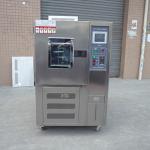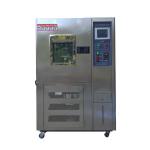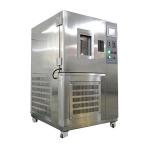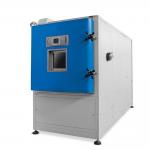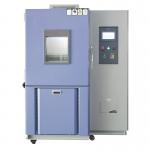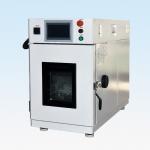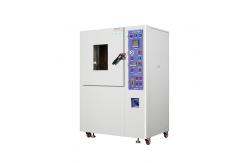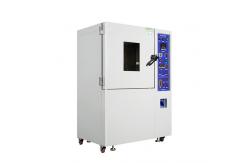In the pharmaceutical realm, where product integrity and efficacy
are non-negotiable, the Energy-saving Stability Testing Chamber
emerges as a vital asset. This chamber is specifically engineered
to address the unique demands of pharmaceutical testing and cold
storage, ensuring that medications maintain their potency and
quality throughout their shelf life. This advanced chamber is dedicated to simulating a wide range of
temperature and humidity conditions that pharmaceutical products
might encounter during storage, transportation, and distribution.
It serves pharmaceutical manufacturers, research institutions, and
regulatory bodies. The primary goal is to conduct stability tests
on drugs, vaccines, and other pharmaceutical formulations. By
subjecting these products to controlled environmental stresses, it
becomes possible to predict their shelf life, evaluate potential
degradation, and ensure compliance with strict industry regulations
and international standards. The energy-saving aspect not only
reduces operational costs but also aligns with sustainable
manufacturing practices. - Efficient Insulation and Durable Construction
- The chamber is constructed with high-quality insulation materials
that minimize heat transfer and maintain a stable internal
environment. The walls, ceiling, and floor are insulated to prevent
temperature fluctuations and maintain precise temperature and
humidity levels. The outer shell is made of durable stainless steel
or corrosion-resistant alloys, ensuring long-term reliability and
protection against external elements. The door is designed with a
heavy-duty sealing mechanism and a viewing window, allowing for
easy monitoring of the test samples without compromising the
internal conditions. The overall structure is engineered to
withstand the rigors of continuous operation and provide a safe and
accurate testing environment.
- Precision Temperature and Humidity Control System
- At the heart of the chamber lies a state-of-the-art temperature and
humidity control system. It can achieve a wide temperature range,
typically from -20°C to +60°C, with an accuracy of ±0.2°C. The
humidity control range extends from 5% to 95% relative humidity,
with an accuracy of ±1.5% RH. The system utilizes energy-efficient
refrigeration units, heaters, humidifiers, and dehumidifiers, all
coordinated by a sophisticated PID controller. Multiple sensors are
strategically placed throughout the chamber to provide real-time
feedback, enabling the control system to make rapid and precise
adjustments to maintain the desired environmental conditions. The
control system also features energy-saving modes, such as adaptive
temperature and humidity setpoints, which optimize energy
consumption based on the actual testing requirements.
- Intuitive Control Panel and Data Acquisition Interface
- The equipment is equipped with an intuitive control panel that
simplifies the operation and parameter setting. Operators can
easily adjust the temperature, humidity, test duration, and other
parameters using a user-friendly interface. The control panel also
provides real-time displays of the current environmental
conditions, as well as any alarms or warnings. The chamber is
integrated with a comprehensive data acquisition system. It records
all relevant test data, including temperature and humidity
histories, rate of change of environmental parameters, and any
observable changes in the test samples. The data can be stored in a
built-in memory or exported to external storage devices for further
analysis. The system can also generate detailed test reports in
various formats, facilitating easy documentation and sharing of
results.
- Safety Features and Alarms
- To ensure the safety of operators and the integrity of the testing
process, the chamber is equipped with a range of safety features.
These include over-temperature and over-current protection,
emergency stop buttons, and alarms for abnormal temperature
fluctuations, humidity levels, or equipment malfunctions. The
safety features are designed to prevent damage to the chamber, the
test samples, and the surrounding environment, providing peace of
mind during the testing operation.
- Temperature Range and Accuracy
- With a temperature range of -20°C to +60°C and an accuracy of
±0.2°C, the chamber can subject pharmaceutical products to a wide
spectrum of temperatures. This is crucial for testing drugs that
may be stored in cold chain conditions or exposed to higher
temperatures during transportation or handling. The accurate
temperature control ensures that the test conditions are precisely
maintained, providing reliable and repeatable results.
- Humidity Range and Accuracy
- The humidity range of 5% to 95% RH, with an accuracy of ±1.5% RH,
allows for a comprehensive evaluation of the effect of moisture on
pharmaceutical products. The ability to precisely control the
humidity level is essential for understanding how drugs and their
packaging respond to different moisture environments, such as the
hygroscopic nature of certain medications or the potential for
condensation in cold storage.
- Testing Volume and Payload Capacity
- The chamber offers a customizable testing volume, typically ranging
from 50L to 500L, depending on the specific model. The payload
capacity can handle a significant amount of test samples, with a
maximum capacity of up to 200 kg, depending on the size and density
of the objects. This allows for efficient testing of a batch of
pharmaceutical products or a single, relatively large item.
- Data Sampling Frequency and Resolution
- The data acquisition system samples data at a frequency of up to
200 Hz, providing a highly detailed record of the temperature and
humidity changes. The resolution of the temperature data is 0.05°C,
and the humidity data is 0.05% RH. This high-resolution data is
invaluable for identifying even the slightest trends and potential
failure points, allowing for a more accurate assessment of product
performance.
- Accurate Simulation of Environmental Conditions
- The primary function of the chamber is to provide a precise and
reliable simulation of temperature and humidity conditions. By
subjecting pharmaceutical products to controlled environmental
stresses, it allows manufacturers and researchers to evaluate their
performance and durability. This is crucial for ensuring the
quality and safety of drugs and vaccines, as any degradation or
damage during storage or transportation could have serious
consequences for patient health.
- Product Design Optimization and Quality Control
- Through a series of tests on different pharmaceutical product
prototypes, the data obtained from the chamber can be used to
optimize product designs and packaging. Engineers can analyze the
behavior of various materials and components under different
temperature and humidity stresses and make modifications to enhance
the overall performance and integrity. The chamber also serves as a
vital tool for quality control, ensuring that each batch of
products meets the required environmental resistance standards. For
example, in the manufacturing of vaccines, testing in the chamber
can help ensure the stability of the vaccine under different
storage and transportation conditions.
- Research and Development Support
- In the field of pharmaceutical research and development, the
Energy-saving Stability Testing Chamber offers valuable insights.
Researchers can use it to study the fundamental properties of drugs
and their interactions with different environmental factors. They
can explore new formulations and packaging materials that are more
resistant to temperature and humidity extremes. For instance,
materials scientists can test the performance of novel drug
coatings or container materials under various environmental
conditions, using the chamber to evaluate their effectiveness and
paving the way for advancements in pharmaceutical technology.
- Compliance Testing and Certification
- The equipment is essential for conducting compliance testing to
meet industry regulations and international standards. The
pharmaceutical industry has strict requirements regarding the
stability and integrity of products under different environmental
conditions, and the chamber can be used to perform tests according
to relevant standards such as ICH guidelines. The test results can
then be used to obtain product certifications and ensure market
acceptance.
- Stringent Manufacturing Process
|
